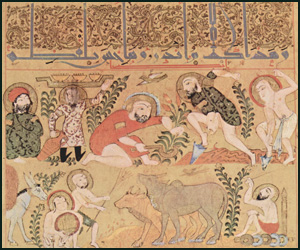|
New Forms of Land Exploitation
Islam,
Watson
points out, freed the
countryside from many arrangements which were `economically
retrograde.’[1]
Equally, Lowe observes that Muslim rule in Sicily
was an improvement over
that of Byzantium
as the latifondi were
divided among freed serfs, and small holders, and agriculture
received the greatest impetus it had ever known.[2]
Thanks to a Muslim custom, uncultivated land became the property
of whoever first broke it, thus encouraging cultivation at the
expense of grazing.[3]
New modes of production brought more agricultural land and
labour, as well as their product, into the market place, and the
forces of competition thus released were intensified by laws
rewarding innovators.[4]
Immamudin quotes from the documents of the School of Arabic
Studies in Madrid the type of contract entered into by
cultivators and landlords for the bringing of waste land (what
would in Arabic be called mawat) under cultivation.[5]Immamudin
also cites examples of share cropping contracts (one would call
these muzara’ah, musaqah, etc. in Arabic) that bear close
resemblance to examples given in the standard Arabic law-books,
and such forms of contract as those studied by Serjeant, and
which too are applicable today.[6]
This
highlights the advanced Islamic conditions in comparison with
Europe, where, England
excepted, only began to
abolish the feudal system late in the 18th century.
The Muslim tax system contributed to such and other
improvements; low rates of taxation helped keep alive a class of
smaller, independent landowners and a relatively prosperous
peasantry.[7]
Prior to Islam, taxes crippled both effort and innovation,
pushing the tendency for large estates to dominate the
countryside and for the peasantry to be enserfed.
The
Muslims also introduced a legal corpus in irrigation to protect
individual rights, and applied lower rate of taxation for land
watered by the Noria than by hand, leading to the prevalence of
small holdings of share-croppers and free farmers, as opposed to
the latifundia of antiquity with their scores of slaves.[8]
Experimental Farming and Botanical Gardens
It has been seen
above how Muslims managed to bring in new crops, adapt them and
diffuse them. They were able to do so mainly thanks to
experimental botanical
gardens. These were often in the charge of leading scientists
such as Ibn Bassal (fl 11th century) and Ibn Wafid
(b. 997-d. ca 1074). These
gardens, according to Watson
, were places `where business was mixed with pleasure, science
with art.’[9]And
these urges acted as strong stimuli for he adaptation of crops
from one place into another.
Abd Errahman I (rule began in 756), who was fond of flowers and
fruits, planted a beautiful garden in imitation of the Rusafah
Villa of Damascus
, a
summer country residence between Palmyra and the Euphrates
valley where he had lived for long with his grand father Hisham.[10]
Gradually, experimental gardens became part of a network which
linked together the agricultural and botanical activities of
distant regions, and so played a role of great importance in the
diffusion of useful plants. Only many centuries later did Europe
possess similar botanical gardens which acted as the same kind
of medium for plant diffusion.[11]
The earliest botanical gardens in Europe appear to have been
planted by Matthaeus Sylvaticus in Salerno
(c.1310) and by
Gualterius in Venice
(c.1330); other places
followed centuries later; Pisa
: in
1543; Padua, Parma and Florence in 1545; Bologna in 1568; Leyden
in 1577; Leipzig in 1580; Konigsberg in 1581; Paris (le Jardin
Royal du Louvre) in 1590; Oxford in 1621 etc.[12]
[1]
A. Watson
; Agricultural innovation, p. 115.
[2]
A.
Lowe: The Barrier; op cit; p. 78.
[3]
Ibid.
[4]
A. Watson
; Agricultural Innovation,
op cit; p. 115.
[5]
In R. B. Serjeant: Agriculture
and
Horticulture; op cit; p. 541.
[6]
Ibid.
[7]
A. Watson
: Agricultural innovation, p. 115.
[8]
Ibid. chapter 21; pp 114-6.
[9]
Ibid. chap 22.
[10]
S.M. Imamuddin: Muslim Spain; Leiden; E. J.
Brill; 1981. p.85.
[11]
A. Watson
: Agricultural innovation, op cit, chap 22.
[12]
See: A. Chiarugi: Le date di fondazione dei primi orti
botanici del mondo,’ Nuovo giornale botanico italiano
new ser. LX (1953) 785-839; A.W. Hill
: The History and function of botanical gardens;
Annals of the Missouri Botanical Garden; II (1915)
185-240; 195 fwd; F. Philippi: Los jardines botanicos.
Santiago de Chile; 1878; etc. |
